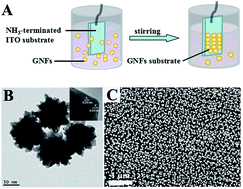Gold nanoflowers modified ITO glass as SERS substrate for carbon tetrachloride-induced acute liver injury in vitro detection
Abstract
For the sensitive and convenient detection of acute liver injury, several methods and materials have been developed. However, it is still a challenge to obtain sensitive, simple detection techniques for acute liver injury. Here, based on a gold nanoflowers (GNFs) modified substrate and 6-mercaptopurine (6-MP) as a surface-enhanced Raman scattering (SERS) signal molecule, a novel method was developed for monitoring carbon tetrachloride (CCl4)-induced acute liver injury of mice. Glutathione (GSH)-triggered and glutathione-s-transferase (GST)-accelerated the turn-off SERS behavior of 6-MP was studied on the GNFs substrate. We found that GSH-triggered GST-accelerated turn-off behavior of 6-MP on the GNFs substrate surface in buffer systems. In CCl4-induced acute liver injury mice tissue extracts without adding GST, the turn-off behavior of 6-MP was also accelerated, the detection intensity from 105 down to 103 counts for 6-MP. The SERS results confirmed that GNFs substrate exhibited strong SERS signal intensity, excellent stability in complex biological environment and detection clinical sample. This study provides a new, rapid and sensitive approach for analysis of trace amounts detection based on SERS coupled with GNFs substrate, which has great potential for analysis of surface chemical properties indicating its potential applicability in biological and biomedical research.


 Please wait while we load your content...
Please wait while we load your content...